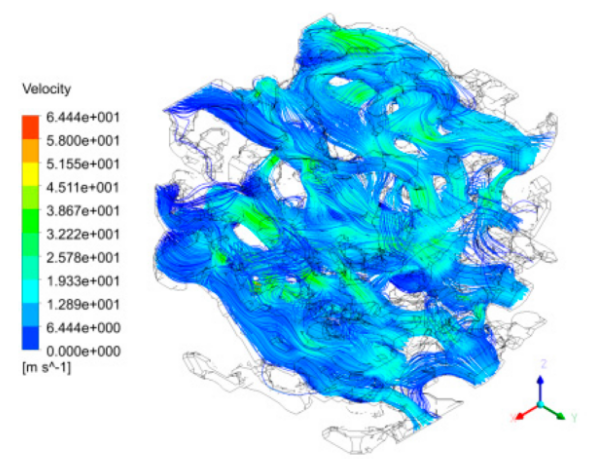Thermo Fisher Scientific › Electron Microscopy › Electron Microscopes › 3D Visualization, Analysis and EM Software › Use Case Gallery
This paper used the X-ray three-dimensional (3D) microscope and acquired, through CT scanning, the 3D data of the long-frame coal sample from the Daliuta Coal Mine.

Then, the 3D datacube reconstructed from the coal’s CT scanning data was visualized with the use of Avizo, an advanced visualization software. By means of a gray-scale segmentation technique, the model of the coal’s micro-pore structure was extracted from the object region, and the precise characterization was then conducted. Finally, the numerical simulation on the water seepage characteristics in the coal micro-pores model under the pressure of 3 MPa was performed on the CFX platform. Results show that the seepage of low-pressure water exhibited preference to the channels with large pore radii, short paths, and short distance from the outlet. The seepage pressure of low-pressure water decreased gradually along the seepage direction, while the seepage velocity of low-pressure water decreased gradually along the direction from the pore center to the wall. Regarding the single-channel seepage behaviors, the seepage velocity and mass flow rate of water seepage in the X direction were the largest, followed by the values of the seepage in the Y direction, and the seepage velocity and mass flow rate of water seepage in the Z direction were the smallest. Compared with the results in single-channel seepage, the dual-channel seepage in the direction of (X + Y) and the multi-channel seepage in the direction of (X + Y + Z) exhibited significant increases in the overall seepage velocity. The present study extends the application of 3D CT scanning data and provides a new idea and approach for exploring the seepage rules in coal micro-pore structures.
This paper used the X-ray three-dimensional (3D) microscope and acquired, through CT scanning, the 3D data of the long-frame coal sample from the Daliuta Coal Mine. Then, the 3D datacube reconstructed from the coal’s CT scanning data was visualized with the use of Avizo, an advanced visualization software. By means of a gray-scale segmentation technique, the model of the coal’s micro-pore structure was extracted from the object region, and the precise characterization was then conducted. Finally, the numerical simulation on the water seepage characteristics in the coal micro-pores model under the pressure of 3 MPa was performed on the CFX platform.
For Research Use Only. Not for use in diagnostic procedures.